As our border collie section has grown considerably here on The Puppy Mag, I’m receiving many questions from owners about border collies with blue eyes.
Many owners weren’t sure if it’s even possible? does it suggest mixed genetics? and could blue eyes cause eye issues down the line? These are all great questions, and eveyrthing is answered below.
This article will act as your complete FAQ guide on all things related to blue-eyed border collies. Let’s start with the basics!
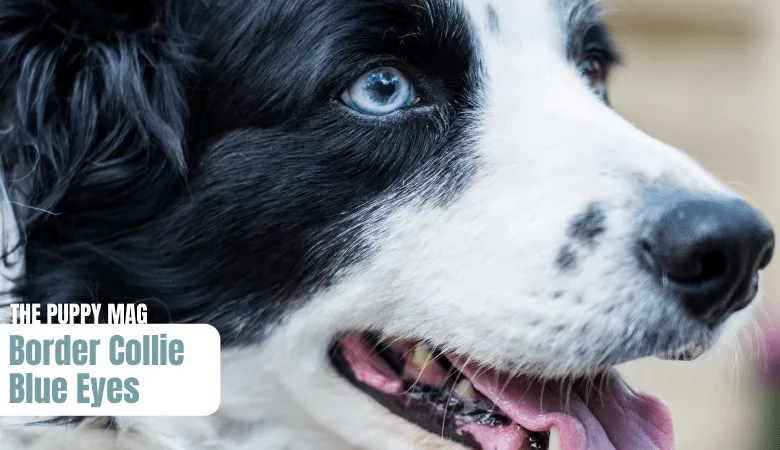
Table of Contents
Can Border Collies Have Blue Eyes?
Yes, border collies can have blue eyes. Although brown is the most common, blue eyes are still possible.
Even purebred collies with regular black and white coats can have one or two blue eyes.
So when we see a blue-eyed collie, it’s wise not to jump to any conclusions about whether they are purebred or not because it’s not a reliable way to tell.
The confusion around this is understandable, though, as blue eyes are often associated with mixed breeding or merle collies.
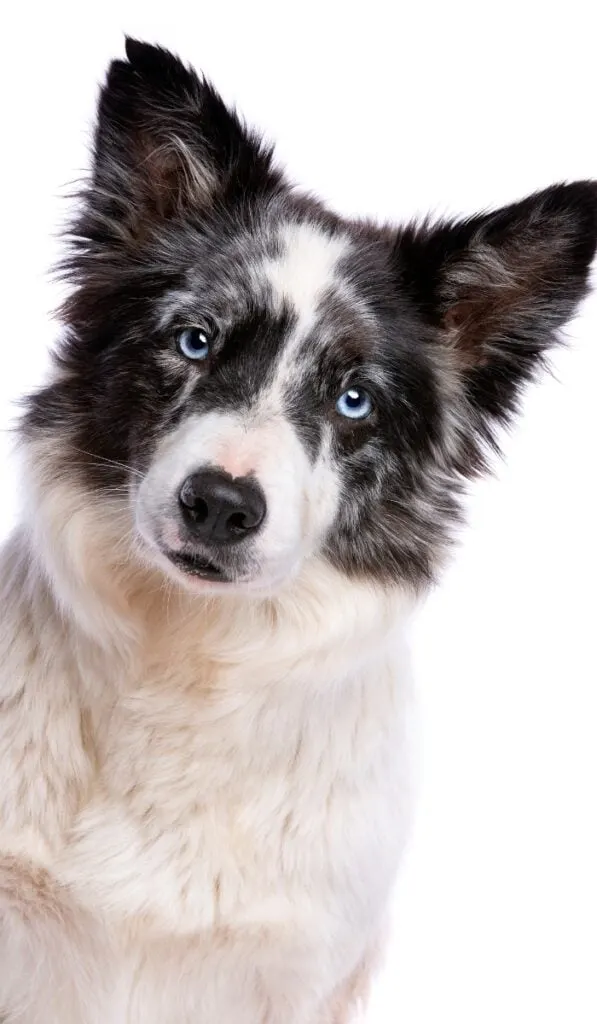
How Do Border Collies Get Blue Eyes?
So how and why do blue eyes happen? I’ll try to explain this as fully as possible while keeping it simple…
➡️ The official term is Heterochromia.
Heterochromia is a hereditary eye condition that happens in various breeds such as border collies.
The amount of melanin found in the iris as well as the evenness of its distribution affects overall eye color.
● Hypochromic is when there is a lack of melanin (pigment) in the iris.
● Hyperchromic is when there is an excess of melanin in the iris.
The amount of melanin (pigment) in the iris determines the eye’s color.
● When eyes are blue or light-colored, there is a lack of melanin.
● When eyes are brown or black, there is a sufficient or excess amount of melanin.
In some cases, an uneven pigment distribution can lead to bi-colored eyes (one blue, one brown) or particolored eyes (blue AND brown in the same eye).
But how do border collies get heterochromia?
🎯 In most cases, Heterochromia is a hereditary condition passed down through genetics (congenital heterochromia).
In rarer cases, Heterochromia can be acquired through injury, inflammation, or certain brain tumors that affect the pigment in the iris.
Additionally, dogs that are piebald or have the merle gene (which border collies sometimes do) very commonly have Heterochromia as a result. But this doesn’t mean all blue-eyed collies are merles…
Source: Mountain View Veterinary Service
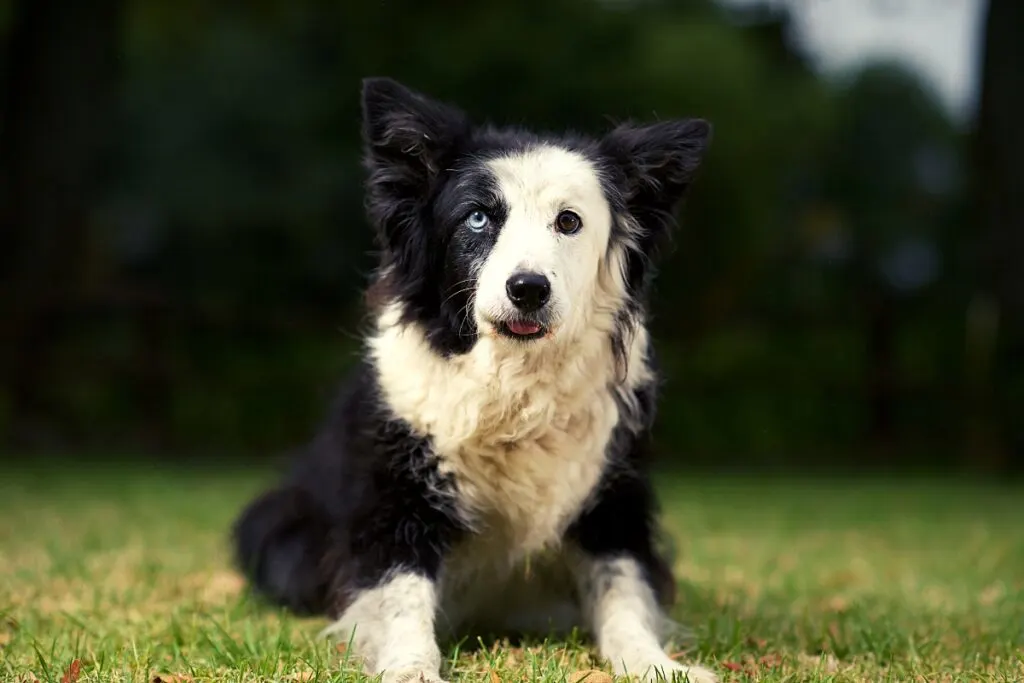
Are Blue-Eyed Border Collies More Prone To Health Issues?
A big concern for owners is whether their blue-eyed beauty is more prone to certain health conditions.
Thankfully, the short and easy answer is no.
Border collies with blue eyes are no more prone to health problems, blindness, or deafness than collies with brown eyes.
It’s often thought that blue-eyed collies are prone to eye problems, vision problems, or deafness. None of this is the case.
Through many studies and decades of testing, heterochromia has never been linked or resulted in bad vision.
Nor does it increase the chance of eye problems that may or may not happen anyway.
➡️ Merles and double merles
A lot of the time, the association of health problems, deafness, and blue eyes comes from the merle gene and double-merles.
⭐ Border collies that inherit a single copy of the merle gene (which should be most) are no more prone to health issues, eye problems, or deafness than any other border collie.
⭐ Unfortunately, those that inherit two copies of the merle gene will practically always be born deaf (at the very least), but also develop more severe health issues and eye problems including cataracts and blindness.
This is why it is discouraged to breed merle dogs together, as the chance of a double merle becomes likely.

Psst! You gotta check out Brain Training For Dogs. It’s a scientifically-proven method for improving a dog’s behavior and intelligence. With these specific brain training exercises, you can help your collie become more obedient and less destructive without a fuss. Okay back to the post!
Do All Border Collie Puppies Have Blue Eyes?
It turns out that all puppies in general, are born with blue eyes. This happens because it can take a while before the pigment develops enough to give them their future eye color.
Even pups without heterochromia or a merle gene, start life with blue eyes.
So if you’ve seen your gorgeous border collie puppy at the breeder with blue eyes, it’s not a guarantee that they will keep them…
Will My Border Collie Puppy’s Eyes Stay Blue?
In many cases, by the time you visit your breeder to view the puppies, their eyes would have started to change color away from blue. Which indicates they probably won’t stay blue.
Eye color typically starts to change by around 4 weeks old. And as breeders shouldn’t be selling puppies before 8 weeks old, there’s a good chance you’ll get to see their future eye color, from the moment you pick them up.
This, however, isn’t always the case. And for some puppies, it can take actually up to a few months for the pigment to develop and give them their eye color!
So it’s not always a sure thing that your puppy’s eyes will stay blue, even if they are when you pick them up.
⭐ What other owners say:
After speaking to dozens of owners trying to find a reliable way to know in advance, there was only one consistent piece of advice I heard…
“If the eye/eyes remain a strong blue color as the weeks pass then there’s a relatively strong chance the eye/eyes will remain blue, but if the blue seems to be washed or grayish then it usually indicates there is some level of pigment development happening.
The pigment could take the eyes just past blue, or all the way to brown.”
While you can look to the parents for further guidance, it’s not always a sure thing. The only way to truly know is to wait. Sigh…
Border Collie Eye Color Chart
Let’s highlight some of the different eye color variations possible in Border Collies. If you have a collie with gorgeous eyes, by all means, send the photo to us and we will add it under the relevant section.
You’ll notice that most collies with heterochromia are in fact merles.
Border collie puppy with two blue eyes (merle)

Border collie with bi-colored eyes
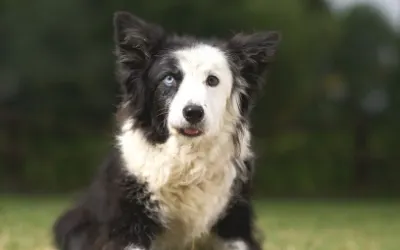

Border collie and a border collie mix with parti-colored eyes (merles)
This is considered the rarest eye color variation.
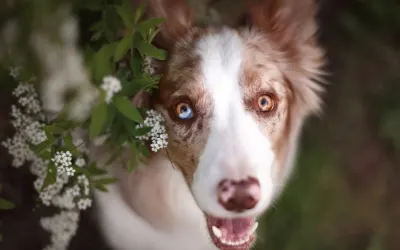

Border collie with brown eyes

Border collie with light amber/green eyes (likely merle)
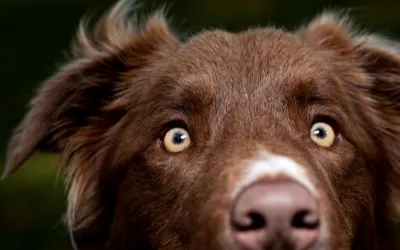
A Brief Overview of Collie Eye Anomaly (CEA)
Unfortunately, collies and herding breeds often develop Collie Eye Anomaly CEA (it’s literally named after them!). This is a congenital genetic condition that can impair a collie’s vision. Although it can lead to blindness, for most, it won’t.
Essentially, CEA happens when the choroid (a collection of blood vessels under the retina) doesn’t form properly. This then affects how the eye absorbs light. This then affects their ability to see.
The best chance of avoiding this issue or at least having it seen to is to have your puppy’s eye examined from around (5-8 weeks).
Fortunately, this issue (if present) can usually be detected early by an eye examination. The older the collie, the harder it is to detect.
CEA does not necessarily happen more in blue-eyed collies or merles, but diagnosing this condition in merles can be extra challenging.
Although there is no real cure for CEA, in most cases, it doesn’t develop enough to cause total vision loss. In some cases, surgery may be an option to help reduce the effects of this condition.
As this is an inherited congenital condition, the only thing we can do when it comes to future prevention is to not breed collies that have this gene.
Thank you for reading!
Be sure to check out more Border Collie articles >>>
Most Recommended For Border Collies
⭐ Best Brushes For Shedding
No matter how much you brush your border collie, if you aren’t using the correct brushes, you won’t be getting the most out of each session! A simple Undercoat Rake and a Slicker Brush are by far the two best brushes to maintain your collie’s coat.
⭐ Best Online Training Program
Brain Training For Dogs has become increasingly popular with working dogs in the last few years and is now recognized as one of the best ways to train dogs, especially border collies, in the most stress-free, positive way.
⭐ Best Low-Calorie Treats
Keep your collie lean and agile by switching out the high-calorie treats and opting for something healthier. Zuke’s Mini Naturals contain only 2 calories per treat and are made from natural ingredients, making these some of the healthiest treats on the market.
Additional source (Pet Health Network)
Additional source (Collie Life)
Additional source (Mountain View Veterinary Services)
